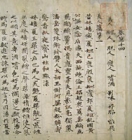Japanese Gallery (Honkan) Room T1
October 12, 2005 (Wed) - November 27, 2005 (Sun)
Ancient books including hand-copied and printed ones are classified according to their contents: Japanese, Chinese (Chinese books and Japanese transcriptions), Buddhist and European books.
Many different versions of ancient books exist in Japan due to their history of transcription and ownership. These versions are the result of the scholarly traditions of families that preserved the books, many with their own way to read the texts while being aided by various marks that were added by them.
From the earliest days Chinese characters were given the utmost importance in the culture of written words. Most important literature, such as legal code that was based on Tang law and history books, was written in Chinese characters. Hiragana and katakana, letter systems unique to Japan, were offshoots created from Chinese characters. In the early 10th century writing according to the Japanese spoken words began, and many excellent literary works, including waka poetry, diaries and fiction, were produced.
As Japan was influenced by Chinese and Korean cultures, numerous books in Chinese were imported, interpreted and transcribed by scholars, they became the basis of an aristocratic education. These even included some books where the originals have been lost in China.
This display features Japanese and Chinese books that were transcribed between the Nara (710-794) through the Muromachi periods (1392-1573). They include the oldest extant copies, the only extant copies as well as books with portions from lost books and writings on the reverse side of the pages. We hope that visitors will be able to understand the long cherished tradition and history of scholarship, while enjoying the excellent penmanship as well as beautiful paper of these treasured books.

